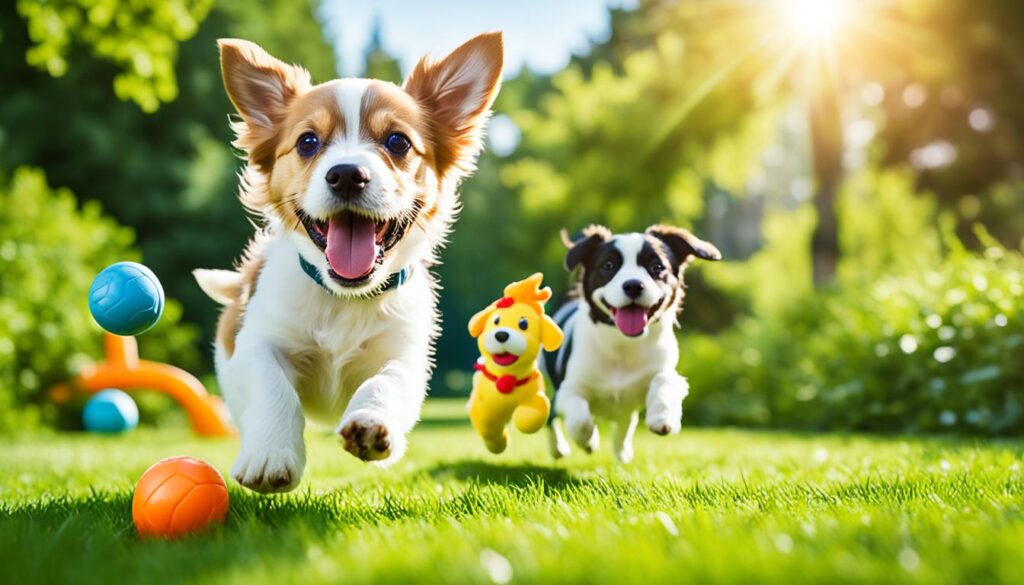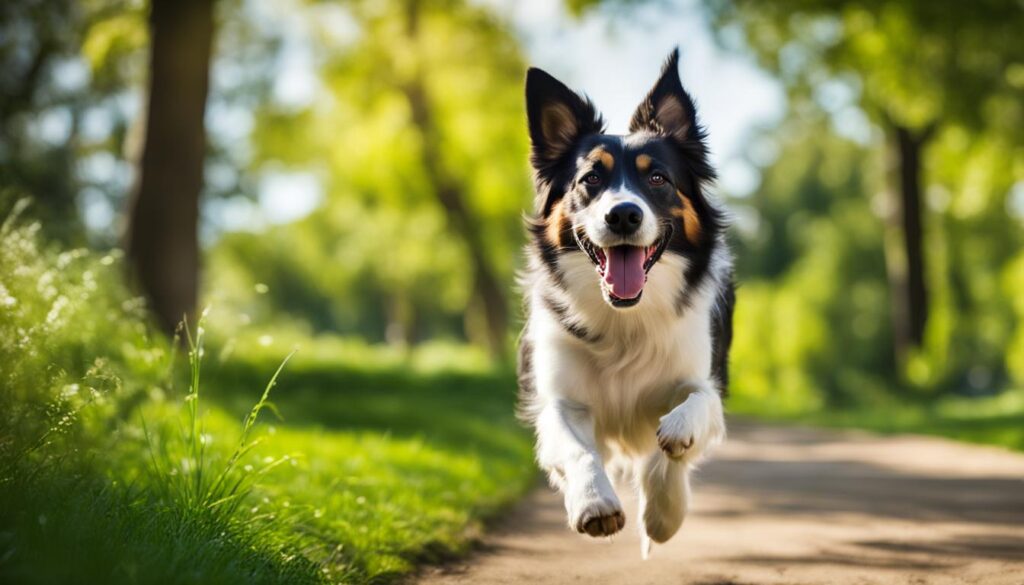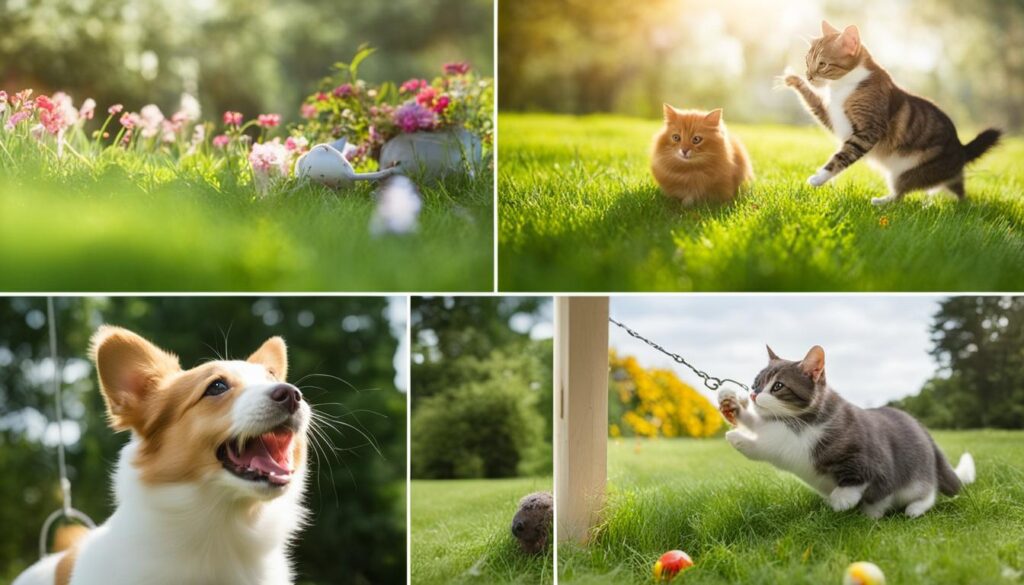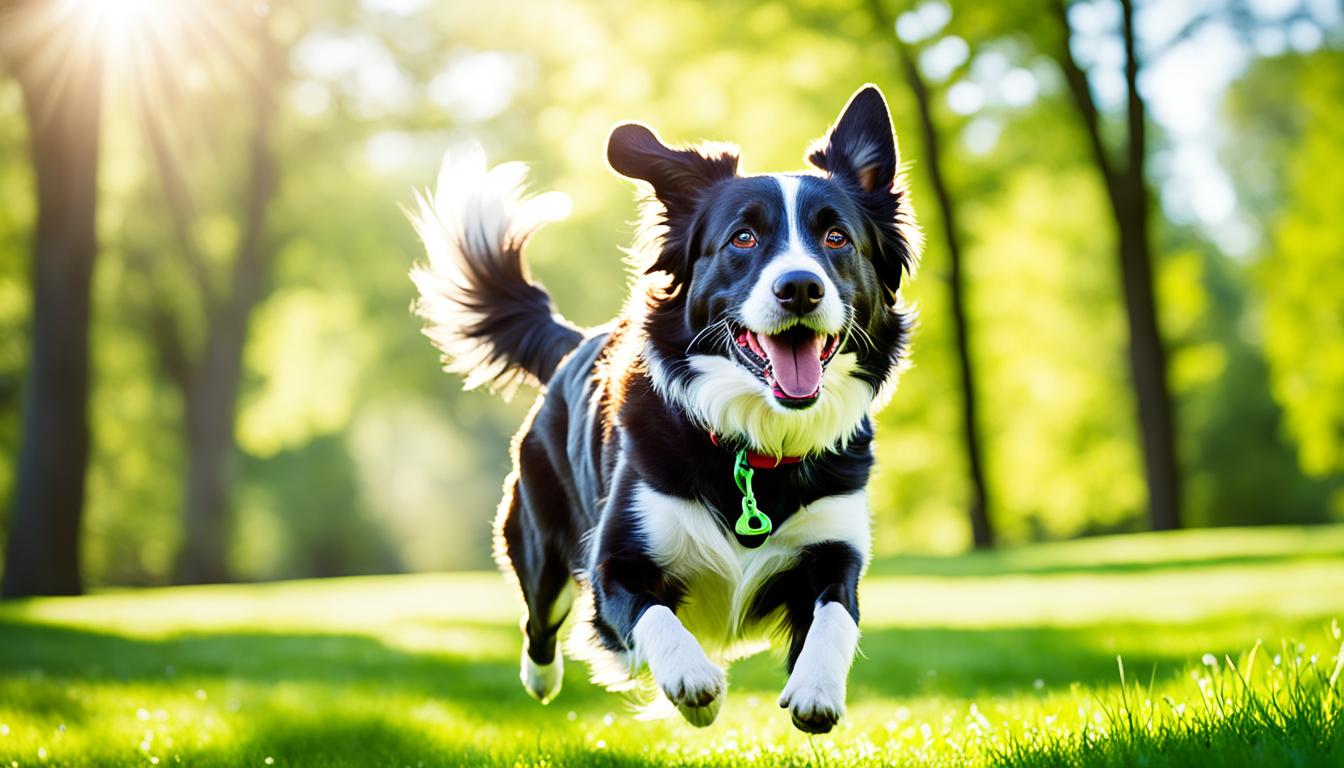At [Your Pet Care Brand], we understand the importance of keeping our pets healthy and happy. One key aspect of pet health and wellness is regular exercise. Just like humans, pets need physical activity to maintain their overall well-being. Exercise plays a vital role in keeping our furry friends in peak condition, both physically and mentally.
Regular exercise has numerous benefits for pets. It helps them maintain a healthy weight, build muscle, and improve cardiovascular health. Exercise is particularly important for puppies and senior pets, as it promotes growth in puppies and helps senior pets maintain their mobility.
Holistic pet care includes preventive measures to promote the long-term health of our pets. Regular exercise is an essential part of preventive pet health, as it can help prevent obesity, reduce the risk of chronic diseases, and even combat behavioral issues. By incorporating exercise into our pets’ routines, we can ensure they lead healthy and fulfilling lives.
Throughout this article, we will explore the importance of exercise for pet health and provide practical tips for integrating exercise into your pet’s daily routine. From daily exercise routines to innovative ways of engaging your pet, we will cover a range of topics to help you keep your furry friend active and happy.
Key Takeaways:
- Regular exercise is essential for maintaining the health and wellness of pets.
- Exercise helps pets maintain a healthy weight, build muscle, and improve cardiovascular health.
- Physical activity is particularly important for puppies and senior pets to promote growth and maintain mobility.
- Regular exercise can help prevent obesity, reduce the risk of chronic diseases, and combat behavioral issues.
- Throughout this article, we will provide practical tips for integrating exercise into your pet’s routine.
Pet Health and Wellness Tips Through Consistent Activity
Consistent exercise is crucial for promoting pet health and wellness. Implementing daily exercise routines ensures that pets engage in regular physical activity to maintain a healthy weight, prevent obesity, and reduce the risk of chronic diseases such as diabetes and heart disease.
Implementing Daily Exercise Routines
Creating daily exercise routines for your pet is essential to their overall well-being. By establishing a consistent schedule, you can make physical activity a regular part of their daily life. Consider the following tips:
- Choose activities that match your pet’s breed, size, age, and energy level.
- Set aside dedicated time each day for exercise, incorporating both indoor and outdoor activities.
- Engage in interactive play sessions using toys, fetch, or hide-and-seek.
- Take your pet for daily walks or jogs to improve cardiovascular health and strengthen muscles.
- Offer mentally stimulating activities such as puzzle toys or agility training.
Understanding the Impact of Physical Activity on Pet Obesity and Chronic Diseases
Regular physical activity plays a vital role in preventing obesity and chronic diseases in pets. Obesity can lead to various health issues, including joint problems, diabetes, and heart disease. By incorporating exercise into your pet’s routine, you can help them maintain a healthy weight and reduce the risk of these conditions.
Physical activity stimulates metabolism, burns calories, and improves overall fitness. Dogs and cats that engage in regular exercise have higher energy expenditure, making it easier for them to maintain a healthy weight. Additionally, exercise aids in muscle development, which can enhance mobility and reduce the strain on joints.
Mental Health Benefits: Reducing Anxiety and Stress in Pets
Exercise not only benefits the physical health of pets but also has significant mental health benefits. Regular physical activity provides an outlet for excess energy, reduces stress levels, and alleviates anxiety in pets. It can help combat behavioral issues that arise from boredom or pent-up energy.
Engaging in exercise releases endorphins, also known as “feel-good” hormones, in pets, promoting a sense of well-being and relaxation. This helps reduce anxiety and stress, leading to improved mental health and overall happiness.
Reducing anxiety and stress through exercise also aids in preventing destructive behaviors, such as excessive chewing, scratching, or barking. By providing outlets for physical and mental stimulation, exercise helps keep pets engaged and content.
Incorporating regular exercise routines into your pet’s daily life is essential for maintaining their health, preventing obesity and chronic diseases, and promoting overall well-being. It not only keeps them physically fit but also supports their mental health, reducing anxiety and stress. By making exercise a priority, you are giving your pet the gift of a healthier and happier life.
The Importance of Exercise for Pets Across All Life Stages
Exercise plays a vital role in maintaining the health and well-being of pets at all life stages. From promoting growth and health in puppies to maintaining mobility in senior pets, regular physical activity is essential for their overall fitness and happiness.
Promoting Growth and Health in Puppies
Puppies require exercise to support their growth and development. Physical activity helps them build strong muscles and bones, as well as establish a healthy weight. Regular exercise also provides mental stimulation, which is important for their cognitive development.

To ensure that puppies get the exercise they need, consider incorporating activities such as short walks, play sessions, and interactive toys into their daily routine. Gradually increase the intensity and duration of exercise as they grow to meet their changing energy levels and physical capabilities.
Maintaining Mobility in Senior Pets
As pets age, maintaining mobility becomes crucial for their overall well-being. Regular exercise helps senior pets manage their weight, prevent muscle loss, and improve joint health. It also provides mental stimulation, which is beneficial for their cognitive function and emotional well-being.
To promote mobility in senior pets, incorporate low-impact exercises such as gentle walks, swimming, and stretching into their daily routine. Consider using joint supplements or consult with a veterinarian for additional support and guidance tailored to your pet’s specific needs.
By prioritizing exercise throughout all life stages, we can contribute to the long-term health and happiness of our beloved pets.
Innovative Ways to Integrate Exercise into Your Pet’s Life
Introducing variety and innovation into your pet’s exercise routine can make it more enjoyable for both you and your furry friend. It’s important to keep your pet engaged and motivated to ensure they get the exercise they need to stay active and healthy.
One fun and creative way to exercise with your pet is by using interactive toys and games. These toys are designed to stimulate your pet’s mind and encourage physical activity. For example, you can try using puzzle toys that dispense treats or toys that require your pet to solve a problem or complete a task. These toys not only keep your pet physically active but also provide mental stimulation, which is essential for their overall well-being.
Another innovative method is using specialized exercise equipment. There are various types of equipment available for different pets, such as treadmills for dogs or cat exercise wheels. These tools can be a great way to provide controlled exercise for your pet, especially in cases where outdoor activities may not be feasible.
Additionally, incorporating playtime into your pet’s routine is a fantastic way to ensure they get the exercise they need. You can engage in activities like fetch, agility training, or even play hide and seek with their favorite toys. These activities not only provide physical exercise but also strengthen the bond between you and your pet.
Remember, it’s essential to choose activities and toys that cater to your pet’s interests and abilities. Understanding their preferences will make exercise time more enjoyable and effective. Always monitor your pet’s comfort level and consult with a veterinarian if you have any concerns about specific exercises or activities.
| Exercise Method | Description |
|---|---|
| Interactive Toys | These toys are designed to stimulate your pet’s mind and encourage physical activity. They provide mental stimulation and keep your pet engaged during exercise. |
| Specialized Exercise Equipment | Equipment like treadmills for dogs or cat exercise wheels offer controlled exercise options for pets, ensuring they get the physical activity they need even in limited outdoor environments. |
| Playtime activities | Engaging in activities like fetch, agility training, or hide and seek with toys provides both physical exercise and strengthens the bond between you and your pet. |
How Regular Physical Activity Strengthens the Human-Animal Bond
Regular physical activity not only benefits pets but also strengthens the bond between humans and animals. Exercise provides opportunities for shared experiences, bonding, and quality time together. When we engage in physical activities with our pets, such as going for walks or playing fetch, we create precious memories and build a deeper connection.
Exercising with our pets allows us to engage with them on a more intimate level, understanding their needs, and responding to their cues. Through physical activity, we learn to communicate with our pets non-verbally, strengthening our understanding and empathy for their well-being.
The human-animal bond is strengthened through the mutual enjoyment and companionship experienced during exercise. Whether it’s a joyful run at the park or a relaxing yoga session, the shared moments of physical activity create a sense of unity and partnership.
Physical activity also enhances the emotional well-being of both humans and animals. Exercise releases endorphins, which are known to boost mood and reduce stress. By engaging in physical activity together, we create a positive and calming environment for ourselves and our pets.
“Exercising with our pets creates a sense of unity and partnership.”
The human-animal bond is further reinforced as we prioritize the physical health of our pets. By making regular exercise a part of their routine, we show our commitment to their well-being and longevity. This shared commitment to health fosters trust and deepens the bond we share with our furry companions.

As we strengthen the human-animal bond through physical activity, we also reap the benefits of improved physical fitness. Exercise not only benefits our pets but also promotes our own health and well-being. It provides an opportunity for us to stay active and lead a healthier lifestyle alongside our beloved pets.
In summary, regular physical activity plays a vital role in strengthening the human-animal bond. By engaging in exercise with our pets, we create shared experiences, build empathy, and foster a sense of unity and partnership. It is through these moments of physical activity that we deepen our connection with our pets and create a lifelong bond built on trust, love, and companionship.
Preventive Pet Health: Combating Behavioral Issues Through Exercise
Regular exercise plays a crucial role in preventive pet health by addressing and combating behavioral issues. Pets who engage in regular physical activity are less likely to exhibit destructive chewing, excessive barking, and other behavioral problems. Exercise also serves as a tool for improved pet behavior training, providing an outlet for excess energy and promoting mental stimulation.
Addressing Destructive Chewing and Excessive Barking
Destructive chewing and excessive barking are common behavioral issues in pets. These behaviors often stem from boredom, anxiety, or a lack of mental and physical stimulation. By incorporating regular exercise into your pet’s routine, you can help alleviate these issues.
Exercise helps redirect their energy and provides a constructive outlet for their natural instincts. Engaging in activities like fetch, agility training, or interactive play can help tire them out physically and mentally, reducing the likelihood of destructive chewing and excessive barking.
Exercise as a Tool for Improved Pet Behavior Training
Exercise is not only beneficial for addressing specific behavioral issues, but it also plays a vital role in overall behavior training. When pets are well-exercised, they are calmer and more receptive to training sessions.
By incorporating exercise into your pet’s routine, you create a foundation of physical and mental wellbeing. This foundation allows for more effective behavior training sessions, as the pet is more focused and eager to learn. The mental stimulation provided by exercise helps pets stay engaged and responsive during training exercises.
Using exercise as a tool for improved behavior training helps establish a positive reinforcement system. Pets learn to associate exercise and physical activity with rewards and positive experiences, reinforcing desirable behaviors.
Overall, preventive pet health involves addressing behavioral issues through regular exercise. By combating destructive chewing, excessive barking, and other behavioral problems, exercise promotes physical and mental wellbeing in pets. Additionally, exercise serves as a valuable tool for improved behavior training, creating a stronger bond between pets and their owners.
Maximizing Pet Wellness with Proper Nutrition and Exercise
When it comes to pet wellness, a holistic approach that combines proper nutrition and exercise is key. Nutrition plays a vital role in supporting your pet’s overall health and fitness, working in conjunction with regular physical activity to maximize their well-being.
Nutrition Tips: The Role of Diet in Conjunction with Exercise
Feeding your pet a balanced and nutritious diet is essential for their overall health and fitness. Just as we need the right fuel for exercise, our pets require a diet that provides the necessary nutrients to support their physical activity and general wellness.
When choosing pet food, opt for high-quality, complete, and balanced options that meet your pet’s specific nutritional needs. Consider their age, size, breed, and any particular health considerations they may have. Consult with your veterinarian for guidance on selecting the right food for your pet.
Additionally, be mindful of the portions you feed your pet. Overfeeding can lead to weight gain, which can negatively impact their overall health and make it more challenging for them to exercise effectively. Follow the feeding guidelines provided by the pet food manufacturer and monitor your pet’s weight regularly to ensure they maintain a healthy body condition.
Holistic Approaches to Pet Health Combining Diet, Grooming, and Fitness
When it comes to pet wellness, taking a holistic approach is key. It involves considering all aspects of your pet’s health, including diet, grooming, and fitness.
Regular grooming is not only about keeping your pet clean and looking their best; it also plays a role in their overall well-being. Proper grooming helps to maintain healthy skin and coat, prevents matting, and allows for early detection of any skin issues or abnormalities.
Incorporating regular exercise into your pet’s routine is essential for their overall fitness and mental well-being. Engaging in physical activity together helps strengthen the bond between you and your pet while also providing them with the exercise they need to maintain a healthy weight and promote optimal physical and mental health.
By combining proper nutrition, regular grooming, and consistent exercise, you can ensure that your pet’s wellness is maximized, supporting their overall health and happiness.

Understanding Your Pet’s Physical Exercise Needs
Understanding your pet’s physical exercise needs is crucial for their overall health and well-being. Just like humans, pets have different activity levels and exercise requirements based on factors such as breed, age, size, and overall health condition.
To determine the right amount of exercise for your pet, it’s important to consider their individual needs. Some breeds, such as Border Collies or Dalmatians, are known for their high energy levels and require more exercise to stay healthy and stimulated. On the other hand, smaller breeds or older pets may have lower exercise needs and may require gentler activities to prevent strain or injury.
Assessing your pet’s activity level is essential in understanding their exercise needs. This can include observing their behavior and energy levels throughout the day. If your pet seems restless or exhibits destructive behaviors, it may indicate that they need more physical activity to expend their energy.
Consulting with a veterinarian can also provide valuable insights into your pet’s exercise needs. Vets can assess your pet’s overall health condition and provide tailored recommendations for exercise routines and activities. They can also offer advice on any specific considerations, such as joint health or weight management.
Meeting your pet’s exercise needs doesn’t have to be complicated. Incorporating regular walks, play sessions, and interactive toys can help keep your pet physically active and mentally stimulated. It’s important to strike a balance between challenging your pet and avoiding overexertion, especially with intense exercises or during extreme weather conditions.

Nurturing Natural Pet Health: Non-Traditional Exercise and Its Advantages
Non-traditional forms of exercise can offer unique benefits for both pets and their owners. Beyond the classic walks and runs, there are exciting and unconventional ways to keep your pet active and engaged. These non-traditional exercise methods can add variety, mental stimulation, and physical challenges to your pet’s routine. Let’s dive into some of the innovative approaches that can help nurture your pet’s natural health.
“Doga” and Other Unique Pet-and-Owner Exercise Forms
One fascinating non-traditional exercise method is “doga,” which combines yoga and bonding with your canine companion. Doga allows you and your dog to stretch, breathe, and relax together, promoting both physical and emotional well-being. Not only does it encourage strength, flexibility, and balance, but it also strengthens the bond between you and your furry friend.
Additionally, there are various other pet-and-owner exercise forms that provide an opportunity for shared activity and bonding. From obstacle courses to dance routines, these unique exercise forms allow you to connect with your pet in fun and exciting ways. The bond that is formed through these activities strengthens your relationship and enhances your overall well-being.
Assessing the Benefits of Interactive Play for Different Pet Species
Interactive play is an excellent way to engage pets of different species in exercise. Whether you have a feline friend or a small furry critter, interactive play offers numerous advantages. It provides mental stimulation, promotes physical fitness, and satisfies your pet’s natural instincts.
For cats, interactive toys such as puzzle feeders and laser pointers can keep them mentally and physically active. These toys mimic hunting behaviors and provide entertainment and exercise at the same time. Similarly, small animals like rabbits and guinea pigs can benefit from interactive play with tunnels, toys, and treat-dispensing gadgets. These activities keep them engaged and help prevent boredom.
Contrarily, for birds and reptiles, interactive play involves providing them with enrichment activities, such as offering puzzle toys, perches, or play gyms. These activities stimulate their minds, encourage physical movement, and prevent behavioral issues that can arise from inactivity.
In summary, incorporating non-traditional pet exercise methods and interactive play into your pet’s routine can have significant advantages. From enhancing the bond between you and your pet to providing mental and physical stimulation, these unique approaches contribute to your pet’s overall health and well-being.
Conclusion
In conclusion, regular exercise is essential for the lifelong health and well-being of our pets. By prioritizing pet exercise, we can provide numerous benefits for our furry companions. Physical fitness is promoted through exercise, helping pets maintain a healthy weight, build muscle, and improve cardiovascular health. Furthermore, exercise has significant mental health benefits, reducing stress and anxiety in pets.
Not only does exercise contribute to the physical and mental well-being of our pets, but it also strengthens the bond between humans and animals. Regular physical activity provides opportunities for shared experiences and quality time together, deepening the human-animal bond. It is a powerful way to connect with our pets on an emotional level.
We encourage a proactive approach to pet fitness and care, by prioritizing regular exercise as an integral part of our pet’s overall wellness routine. Understanding and meeting our pet’s physical exercise needs based on their breed, age, size, and activity level is crucial. By implementing daily exercise routines and incorporating innovative and non-traditional exercise forms, we can ensure our pets lead healthy and fulfilling lives.
FAQ
How often should I exercise my pet?
The frequency of exercise depends on your pet’s breed, age, size, and activity level. As a general guideline, dogs typically require at least 30 minutes to 2 hours of exercise per day, while cats usually benefit from short bursts of playtime throughout the day. Consult with your veterinarian to determine the appropriate exercise routine for your pet.
What are some fun exercise ideas for pets?
There are plenty of ways to keep your pet active and entertained. For dogs, you can take them on walks, play fetch, or engage in agility training. Cats enjoy interactive toys, climbing towers, and puzzles. Other pets, such as rabbits or birds, may enjoy supervised playtime outside of their cages. Experiment with different activities to discover what your pet enjoys most.
Are there any exercise restrictions for senior pets?
While regular exercise is crucial for senior pets, it’s important to consider their limitations. Low-impact exercises like gentle walks or swimming are usually recommended. Avoid strenuous activities, long hikes, or excessive jumping, as these can put unnecessary strain on their joints. Consult with your veterinarian for tailored exercise recommendations for your senior pet.
Can indoor cats get enough exercise?
Absolutely! Indoor cats can still engage in physical activity. Provide them with interactive toys, climbing trees, or even set up an obstacle course inside your home. You can also dedicate a specific playtime each day to encourage exercise. Engage their natural instincts by incorporating toys that simulate hunting or chasing prey.
How can I motivate my pet to exercise?
Making exercise fun and rewarding can encourage your pet to stay active. Use treats or praise as positive reinforcement during exercise sessions. Incorporate interactive toys that offer mental stimulation along with physical activity. Consistency is key, so establish a regular exercise routine that your pet can anticipate and enjoy.
Can I exercise my pet indoors during bad weather?
Absolutely! Bad weather doesn’t have to hinder your pet’s exercise routine. Indoor activities like playing fetch in a hallway or using puzzle toys can keep them engaged and active. You can also teach them new tricks or practice obedience training exercises indoors. Just make sure there is enough space and minimal hazards for safe play.
Does my pet need to warm up before exercise?
Just like humans, pets can benefit from a warm-up before intense exercise. Start with a short walk or gentle playtime to gradually increase their heart rate and warm up their muscles. This helps prevent strained muscles or injuries. Similarly, end each exercise session with a cool-down period to gradually decrease their heart rate.
Can my pet exercise too much?
While regular exercise is important, overexertion can lead to exhaustion or injuries. Observe your pet’s behavior during and after exercise. If they show signs of fatigue, excessive panting, or become reluctant to continue, it may be a sign to take a break. Consult with your veterinarian for personalized exercise guidelines based on your pet’s health and condition.
What are the benefits of exercising with my pet?
Exercising with your pet provides not only physical benefits but also strengthens the bond between you. It creates shared experiences, increases trust, and allows for quality time together. Additionally, exercising with your pet can improve your own fitness levels and overall well-being.
Are there any exercises I should avoid for my pet?
Some exercises may not be suitable for certain pets due to breed-specific traits or health conditions. For example, brachycephalic (short-nosed) dog breeds may have difficulty with intense exercise. It’s crucial to consult with your veterinarian to determine any exercise restrictions or modifications based on your pet’s individual needs.
Source Links
- https://www.mainstreetvets.co/blog/the-importance-of-exercise-for-your-pets-physical-and-mental-health/
- https://chhs.source.colostate.edu/exercise-good-for-you-and-your-pet/
- https://www.ncbi.nlm.nih.gov/pmc/articles/PMC10262044/

